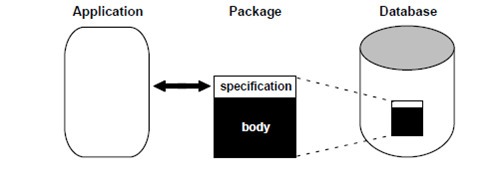What Is a Package?
The package is a schema object that group logically related PL/SQL items, types, and subprograms. The Packages usually have 2 parts, a specification & a body, though many times the body is needless. The specification is the interface to your applications; it declares the type, constants, variables, exceptions, cursors, and subprograms accessible for use. The body fully defines the cursors & subprograms, and so equipment the specification.
The figure shows, the specification as an operational interface and of the body as the "black box." You can enhance, debug, or replace the package body without changing the interface to the package.

Figure: Package Interface
To build packages, use the CREATE PACKAGE statement that you can execute interactively from the SQL Plus. The syntax for the same is as shown:
CREATE [OR REPLACE] PACKAGE package_name
[AUTHID {CURRENT_USER | DEFINER}] {IS | AS}
[type_definition [type_definition] ...]
[cursor_spec [cursor_spec] ...]
[item_declaration [item_declaration] ...]
[{subprogram_spec | call_spec} [{subprogram_spec | call_spec}]...]
END [package_name];
[CREATE [OR REPLACE] PACKAGE BODY package_name {IS | AS}
[type_definition [type_definition] ...]
[cursor_body [cursor_body] ...]
[item_declaration [item_declaration] ...]
[{subprogram_spec | call_spec} [{subprogram_spec | call_spec}]...]
[BEGIN
sequence_of_statements]
END [package_name];]
The specifications hold the public declarations that are visible to your application. The body holds the implementation details and private declarations that are hidden from your application. The declarative section below of the package body is the optional initialization section that typically holds the statements that initialize the package variables. The AUTHID clause determine whether all the packaged subprograms execute with the privileges of their definer or invoker, and whether their unqualified references to schema objects are solved in the schema of the definer or invoker.
The call specification publishes a Java method or external C function in the Oracle data dictionary. The call specification publishes the routine by mapping its parameter types, name, and return type to their SQL counterparts.
In the illustration below, you package a cursor, a record type, and two employment procedures. Note that the procedure hire_employee uses the database series empno_seq and the function SYSDATE to insert a new employee number & hire date, correspondingly.
CREATE OR REPLACE PACKAGE emp_actions AS -- spec
TYPE EmpRecTyp IS RECORD (emp_id INTEGER, salary REAL);
CURSOR desc_salary RETURN EmpRecTyp;
PROCEDURE hire_employee (
ename VARCHAR2,
job VARCHAR2,
mgr NUMBER,
sal NUMBER,
comm NUMBER,
deptno NUMBER);
PROCEDURE fire_employee (emp_id NUMBER);
END emp_actions;
CREATE OR REPLACE PACKAGE BODY emp_actions AS -- body
CURSOR desc_salary RETURN EmpRecTyp IS
SELECT empno, sal FROM emp ORDER BY sal DESC;
PROCEDURE hire_employee (
ename VARCHAR2,
job VARCHAR2,
mgr NUMBER,
sal NUMBER,
comm NUMBER,
deptno NUMBER) IS
BEGIN
INSERT INTO emp VALUES (empno_seq.NEXTVAL, ename, job,
mgr, SYSDATE, sal, comm, deptno);
END hire_employee;
PROCEDURE fire_employee (emp_id NUMBER) IS
BEGIN
DELETE FROM emp WHERE empno = emp_id;
END fire_employee;
END emp_actions;
The declarations in the package specification are only visible & accessible to the applications.
The Implementation details in the package body are hidden and inaccessible. Therefore, you can change the body without having to recompile the calling programs.